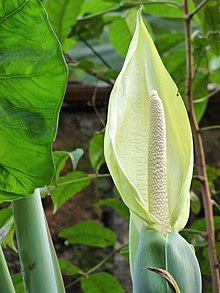วงศ์บอน
| วงศ์บอน ช่วงเวลาที่มีชีวิตอยู่: 115–0Ma ยุคครีเทเชียสตอนต้น[1] - ปัจจุบัน | |
|---|---|

| |
| ช่อดอกของ Spathiphyllum cochlearispathum | |
| การจำแนกชั้นทางวิทยาศาสตร์ | |
| อาณาจักร: | พืช Plantae |
| เคลด: | พืชมีท่อลำเลียง Tracheophytes |
| เคลด: | พืชดอก Angiosperms |
| เคลด: | พืชใบเลี้ยงเดี่ยว Monocots |
| อันดับ: | อันดับขาเขียด Alismatales |
| วงศ์: | วงศ์บอน Araceae Juss.[2] |
| วงศ์ย่อย | |


วงศ์บอน (ชื่อวิทยาศาสตร์: Araceae) เป็นวงศ์ของพืชมีดอกที่เป็นพืชใบเลี้ยงเดี่ยว ที่มีดอกเป็นดอกช่อแบบช่อเชิงลดมีกาบ (spadix) ประกอบด้วยสมาชิก 140 สกุลและประมาณ 4,075 ชนิด[3] ส่วนใหญ่กระจายพันธุ์ในโลกใหม่เขตร้อน บางส่วนอยู่ในเขตร้อนของโลกเก่าและเขตอบอุ่นทางเหนือ ยางของพืชวงศ์นี้มีพิษ
อนุกรมวิธาน
[แก้]วิวัฒนาการชาติพันธุ์
[แก้]ตารางวิวัฒนาการชาติพันธุ์จาก Angiosperm Phylogeny Website[4]
| Araceae |
| ||||||||||||||||||||||||||||||||||||||||||
สกุล
[แก้]บันทึกฟอสซิล
[แก้]วงศ์บอนเป็นหนึ่งในพืชที่มีบันทึกฟอสซิลที่เก่าแก่ที่สุดในบรรดาพืชดอก โดยฟอสซิสแรกปรากฏขึ้นในช่วงยุคครีเทเชียสตอนต้น[1][5] ฟอสซิลที่สำคัญจากยุคครีเทเชียสตอนต้น ได้แก่: Spixiarum kipea,[6] aroid จากบราซิลในสมัย Aptian ตอนปลาย[1] Orontiophyllum ferreri ใบ aroid จากสเปนในสมัย Albian ตอนปลาย[1] และ Turolospadix bogneri ช่อเชิงลดมีกาบ aroid จากสเปนในสมัย Albian ตอนปลาย[1]
อ้างอิง
[แก้]- ↑ 1.0 1.1 1.2 1.3 1.4 Sender, L.M., Doyle, J.A., Upchurch, J.R. Jr., Villanueva-Amadoz, U. and Diez J.B. 2019. Leaf and inflorescence evidence for near-basal Araceae and an unexpected diversity of other monocots from the late Early Cretaceous of Spain. Journal of Systematic Palaeontology, vol. 17, p. 1093–1126.
- ↑ Angiosperm Phylogeny Group (2009), "An update of the Angiosperm Phylogeny Group classification for the orders and families of flowering plants: APG III", Botanical Journal of the Linnean Society, 161 (2): 105–121, doi:10.1111/j.1095-8339.2009.00996.x
- ↑ Christenhusz, M. J. M. & Byng, J. W. (2016). "The number of known plants species in the world and its annual increase". Phytotaxa. Magnolia Press. 261 (3): 201–217. doi:10.11646/phytotaxa.261.3.1.
- ↑ Stevens, P.F. (2001). "Araceae". Angiosperm Phylogeny Website. 13. สืบค้นเมื่อ 30 December 2017.
- ↑ Nauheimer, L., Metzler, D. and Renner, S.S. 2012. Global history of the ancient monocot family Araceae inferred with models accounting for past continental positions and previous ranges based on fossils. New Phytologist, vol. 195, p. 938-950.
- ↑ Coiffard, C., Mohr, B.A.R. and Bernardes de Oliveira, M.E.C. 2013. The Early Cretaceous aroid, Spixiarum kipea gen. et sp. nov., and implications on early dispersal and ecology of basal monocots. Taxon, vol. 62. p. 997-1008.
อ่านเพิ่ม
[แก้]- Bown, Deni (2000). Aroids: Plants of the Arum Family [ILLUSTRATED]. Timber Press. ISBN 0-88192-485-7
- Croat, Thomas B (1998). "History and Current Status of Systematic Research with Araceae". Aroideana. 21. online
- Grayum, Michael H (1990). "Evolution and Phylogeny of the Araceae". Annals of the Missouri Botanical Garden. 77 (4): 628–697. doi:10.2307/2399668. JSTOR 2399668.
- Keating R C (2004). "Vegetative anatomical data and its relationship to a revised classification of the genera of Araceae". Annals of the Missouri Botanical Garden. 91 (3): 485–494. JSTOR 3298625.
